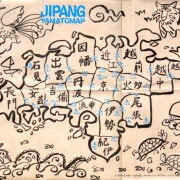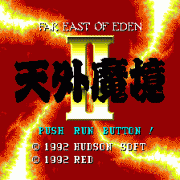Tengai Makyo II Complete Music Recording
In 1997, when everyone was about the PlayStation, Saturn and Nintendo 64, I bought a PC Engine. Take that, trendy retro kids ~
Unlike many of my purchases at the time, during that golden era where 8/16 bit stuff was so cheap because of the new generation systems, I paid quite a bit for that one. Because even back, then it was rare. Why did I buy it ? For many reasons, actually. The system had always fascinated me, with it’s pixel graphics, CDDA sounds and animated cut scenes. And because the word among the elite nerds of the time was that the King among Kings of Japanese RPGs was on it. Tengai Makyo II.
I was playing a lot of Japanese RPGs back then. In Japanese. Not speaking the language. While that may seem absurd nowadays, you have to put this back in context and realize that there were very few translated JRPGs back then. Sure, I didn’t always get what was going on, but guessing the story and making it advance despite the language barrier felt like an extra layer of adventure to me. Could I do it again ? Nope. Did I ever have as much pleasure playing games as I did back then ? Double nope.
To play a Japanese RPG during these days, you first had to even hear about it. Sure, there was a specialized press, but not every kids could afford a monthly subscription, and even if you did there was still a good chance some games wouldn’t get reviewed in the import sections which were pretty limited.
So you had the chance to read a 20 lines review about this new Squaresoft game called Bahamut Lagoon. Great. Now you had to actually find it. Yeah, even living in a big city like Paris, finding import games could prove quite a challenge, and would often cost you an harm if you wanted it early on. Thankfully, there was the second hand market. Import games, especially RPGs, would often be tossed in a corner to collect dust if they were ever resold in shops, ’cause really there wasn’t a lot of people who wanted to play those back then. And that’s when you had to pop in at the right time. I’ll always remember my first Chrono Trigger J copy I snagged for nothing in one of these shops. <3
So you had your game. Now you could pop it in your EU/JAP cartridge adapter, or into your Japanese or US SFC/SNES if you were fancy enough to have one. BTW, remember how the SNES of choice used to be the US one because you could saw the edges of the cartridge slot so both US and Jap games would fit in ? Hi5 if you had one of those. Anyways, yeah, playing Japanese RPGs in Japanese wasn't usually that hard. If you got stuck you could always go back and talk to every NPCs to unlock whatever was blocking the story. That was my usual line of action. And yes, it was fun. No really it was !

Back to Tengai Makyo II. I was warned before I bought it that this one was hardcore if you didn’t speak Japanese. And guess what ? It was. This game’s universe was huge for it’s time. I mean, look at the map. See how it represents Japan and how it’s separated into regions ? Well, I’ve played some RPGs whose entire worlds would fit in one of those regions. Each would contain a capital, several towns, dungeons, secret areas, and each of those places would have quests linked to them. Worse, as you would progress through the game, you would really often have to go back to a previous region to talk to one specific guy to unlock something, or even complete a whole new quest in a previously visited area. This is the standard for all Tengai Makyo games, but none ever felt as huge as Tengai II did, even Tengai IV on the Saturn. This is what earned the game the title of King of RPGs at the time in Japan. What kind of gaming experience was it for a non Japanese speaking teenager ? Well, it was awesome.
To give you an example, I didn’t feel as immersed in a cohesive game universe until I played Skyrim almost 20 years later. Even without speaking Japanese, you could feel the world live around you. The enormous amount of small towns and NPCs, the different cultures in each regions, their various wildlife and landscapes. Quite an accomplishment for a console which, all in all, was less technologically advanced than a simple SNES. It’s like the development team, Red, decided to see how big you could make a 16 bit RPG on a CD just for the art of it, ’cause there was really no need for RPGs to be that huge to be commercially successful back then. The story, or what I could grasp of the big lines, is a classic archetypal “chosen ones” with a few twists, with each of the main protagonists being super charismatic. Even a relatively “bland” character like Kinou turns out to be a complete surprise as you progress through the game.
Talking about progress, what about mine you ask ? Well, I got though 3/4 of the game, region wise at least. I couldn’t have done it without the help of Greg from French magazine Joypad, and André, lord of all obscure Japanese game things in the Jussieu game shop district in the 90s, which I both harassed on the phone for months whenever I got completely stuck in the game (and it happened a lot “oh yeah to enter that castle you have to unequip all your weapons” duh !). Many thanks to them. If you read this, drop me a line please. <3 As I played through the game, I kept a walkthrough diary of my progress. You can actually see a very abridged, incomplete version of it here, that the friend I lend it to back then posted on the web more than 10 years ago. PJP / Umaro, if you read this, do you still have this ? xD
And then … one fateful night, at 100+ hours gameplay, my PC Engine fried, and I never played the game again since then. Well, that’s a lie. I did. I attempted to replay it several times in the last 10 years, but hey, I’m no teenager anymore. That magic is gone. While I doubt anyone will ever go through the gigantic work of translating it, I would for sure be all over that, though.
What’s left ? Oh right, the music ! Well, the music is just great. You got CDDA orchestral tracks by Joe Hisaishi of Ghibli fame, here, and some even sound a bit like Totoro. The PSG chip sounds are great too, and the whole thing blends really well together. This release consists of the CDDA tracks mixed chronologically with encodings of the HES files. This is a bit more complete than the official CD, and also better sounding imho.
Enjoy !



Leave a Reply